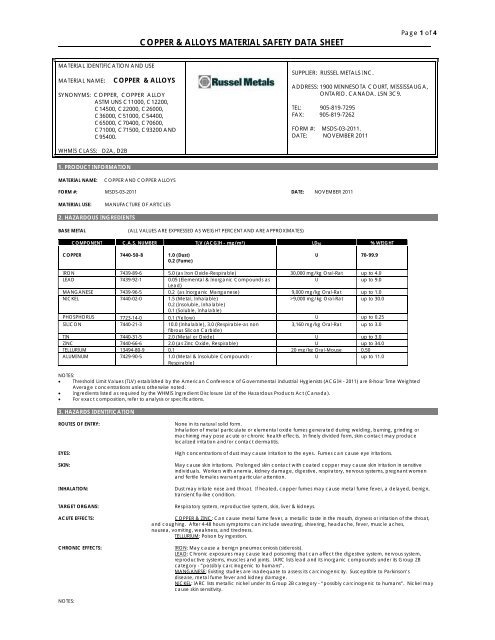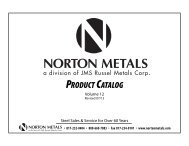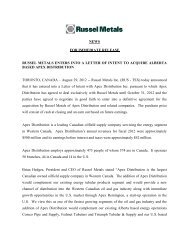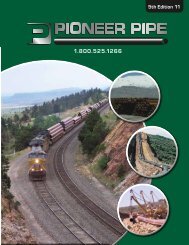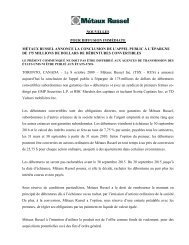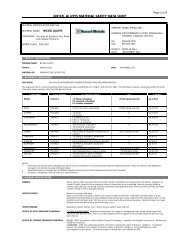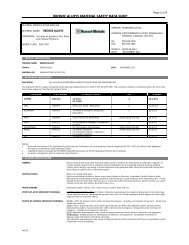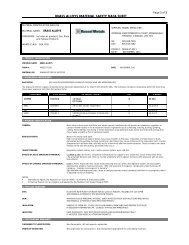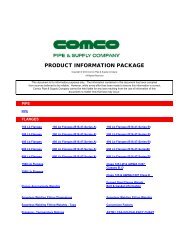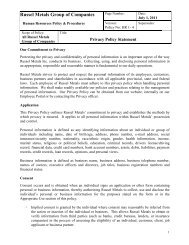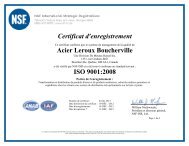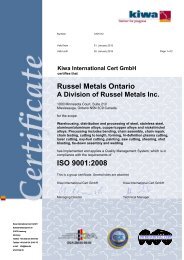MSDS - Copper and Alloys - Russel Metals, Inc.
MSDS - Copper and Alloys - Russel Metals, Inc.
MSDS - Copper and Alloys - Russel Metals, Inc.
Create successful ePaper yourself
Turn your PDF publications into a flip-book with our unique Google optimized e-Paper software.
COPPER & ALLOYS MATERIAL SAFETY DATA SHEET<br />
Page 1 of 4<br />
MATERIAL IDENTIFICATION AND USE<br />
MATERIAL NAME:<br />
COPPER & ALLOYS<br />
SYNONYMS: COPPER, COPPER ALLOY<br />
ASTM UNS C11000, C12200,<br />
C14500, C22000, C26000,<br />
C36000, C51000, C54400,<br />
C65000, C70400, C70600,<br />
C71000, C71500, C93200 AND<br />
C95400.<br />
SUPPLIER: RUSSEL METALS INC.<br />
ADDRESS: 1900 MINNESOTA COURT, MISSISSAUGA,<br />
ONTARIO. CANADA. L5N 3C9.<br />
TEL: 905-819-7295<br />
FAX: 905-819-7262<br />
FORM #: <strong>MSDS</strong>-03-2011.<br />
DATE: NOVEMBER 2011<br />
WHMIS CLASS: D2A, D2B<br />
1. PRODUCT INFORMATION<br />
MATERIAL NAME:<br />
COPPER AND COPPER ALLOYS<br />
FORM #: <strong>MSDS</strong>-03-2011 DATE: NOVEMBER 2011<br />
MATERIAL USE:<br />
MANUFACTURE OF ARTICLES<br />
2. HAZARDOUS INGREDIENTS<br />
BASE METAL<br />
(ALL VALUES ARE EXPRESSED AS WEIGHT PERCENT AND ARE APPROXIMATES)<br />
COMPONENT C.A.S. NUMBER TLV (ACGIH - mg/m 3 ) LD50 % WEIGHT<br />
COPPER 7440-50-8 1.0 (Dust)<br />
0.2 (Fume)<br />
U 70-99.9<br />
IRON 7439-89-6 5.0 (as Iron Oxide-Respirable) 30,000 mg/kg Oral-Rat up to 4.0<br />
LEAD 7439-92-1 0.05 (Elemental & Inorganic Compounds as<br />
U up to 9.0<br />
Lead)<br />
MANGANESE 7439-96-5 0.2 (as Inorganic Manganese) 9,000 mg/kg Oral-Rat up to 1.0<br />
NICKEL 7440-02-0 1.5 (Metal, Inhalable)<br />
>9,000 mg/kg Oral-Rat up to 30.0<br />
0.2 (Insoluble, Inhalable)<br />
0.1 (Soluble, Inhalable)<br />
PHOSPHORUS 7723-14-0 0.1 (Yellow) U up to 0.25<br />
SILICON 7440-21-3 10.0 (Inhalable), 3.0 (Respirable-as non<br />
3,160 mg/kg Oral-Rat up to 3.0<br />
fibrous Silicon Carbide)<br />
TIN 7440-31-5 2.0 (Metal or Oxide) U up to 3.0<br />
ZINC 7440-66-6 2.0 (as Zinc Oxide, Respirable) U up to 34.0<br />
TELLURIUM 13494-80-9 0.1 20 mg/kg Oral-Mouse 0.50<br />
ALUMINUM 7429-90-5 1.0 (Metal & Insoluble Compounds -<br />
Respirable)<br />
U up to 11.0<br />
NOTES:<br />
Threshold Limit Values (TLV) established by the American Conference of Governmental Industrial Hygienists (ACGIH - 2011) are 8-hour Time Weighted<br />
Average concentrations unless otherwise noted.<br />
Ingredients listed as required by the WHMIS Ingredient Disclosure List of the Hazardous Products Act (Canada).<br />
For exact composition, refer to analysis or specifications.<br />
3. HAZARDS IDENTIFICATION<br />
ROUTES OF ENTRY:<br />
EYES:<br />
SKIN:<br />
INHALATION:<br />
TARGET ORGANS:<br />
ACUTE EFFECTS:<br />
CHRONIC EFFECTS:<br />
None in its natural solid form.<br />
Inhalation of metal particulate or elemental oxide fumes generated during welding, burning, grinding or<br />
machining may pose acute or chronic health effects. In finely divided form, skin contact may produce<br />
localized irritation <strong>and</strong>/or contact dermatitis.<br />
High concentrations of dust may cause irritation to the eyes. Fumes can cause eye irritations.<br />
May cause skin irritations. Prolonged skin contact with coated copper may cause skin irritation in sensitive<br />
individuals. Workers with anemia, kidney damage, digestive, respiratory, nervous systems, pregnant women<br />
<strong>and</strong> fertile females warrant particular attention.<br />
Dust may irritate nose <strong>and</strong> throat. If heated, copper fumes may cause metal fume fever, a delayed, benign,<br />
transient flu-like condition.<br />
Respiratory system, reproductive system, skin, liver & kidneys.<br />
COPPER & ZINC: Can cause metal fume fever, a metallic taste in the mouth, dryness or irritation of the throat,<br />
<strong>and</strong> coughing. After 4-48 hours symptoms can include sweating, shivering, headache, fever, muscle aches,<br />
nausea, vomiting, weakness, <strong>and</strong> tiredness.<br />
TELLURIUM: Poison by ingestion.<br />
IRON: May cause a benign pneumoconiosis (siderosis).<br />
LEAD: Chronic exposures may cause lead poisoning that can affect the digestive system, nervous system,<br />
reproductive systems, muscles <strong>and</strong> joints. IARC lists lead <strong>and</strong> its inorganic compounds under its Group 2B<br />
category - “possibly carcinogenic to humans”.<br />
MANGANESE: Existing studies are inadequate to assess its carcinogenicity. Susceptible to Parkinson’s<br />
disease, metal fume fever <strong>and</strong> kidney damage.<br />
NICKEL: IARC lists metallic nickel under its Group 2B category - “possibly carcinogenic to humans”. Nickel may<br />
cause skin sensitivity.<br />
NOTES:
COPPER & ALLOYS MATERIAL SAFETY DATA SHEET<br />
Page 2 of 4<br />
International Agency for Research on Cancer (IARC) - Summaries & Evaluations (2008).<br />
3rd Annual Report on Carcinogens as prepared by the National Toxicology Program (NTP).<br />
4. FIRST AID MEASURES<br />
EYES:<br />
SKIN:<br />
INHALATION:<br />
INGESTION:<br />
DUST ACTS AS A FOREIGN BODY. FLUSH EYES WITH PLENTY OF WATER FOR AT LEAST 15 MINUTES.<br />
SEEK MEDICAL ATTENTION IF EYE IRRITATION PERSISTS.<br />
MAINTAIN GOOD PERSONAL HYGIENE. WASH AFFECTED AREA WITH MILD SOAP AND WATER.<br />
SEEK MEDICAL ATTENTION IF SKIN IRRITATION PERSISTS.<br />
REMOVE TO FRESH AIR. CHECK FOR CLEAR AIRWAY, BREATHING AND PRESENCE OF PULSE.<br />
IF NECESSARY ADMINISTER CPR. CONSULT A PHYSICIAN IMMEDIATELY.<br />
RARE IN INDUSTRY. DUST MAY IRRITATE MOUTH AND GASTROINTESTINAL TRACT.<br />
IF INGESTED, SEEK MEDICAL ATTENTION PROMPTLY.<br />
5. FIRE FIGHTING MEASURES<br />
FLAMMABILITY CLASSIFICATION:<br />
MEANS OF EXTINCTION:<br />
No, not flammable.<br />
None. Use extinguishers appropriate for surrounding materials.<br />
FLASH POINT (ºC): N/A AUTO-IGNITION TEMP (ºC): N/A<br />
UPPER FLAMMABLE LIMIT % BY VOL.: N/A LOWER FLAMMABLE LIMIT % BY VOL.: N/A<br />
SENSITIVITY TO STATIC DISCHARGE: N/A EXPLOSION DATA (SENSITIVITY TO IMPACT): No<br />
HAZARDOUS COMBUSTION PRODUCTS:<br />
UNUSUAL FIRE HAZARDS:<br />
SPECIAL FIRE FIGHTING:<br />
<strong>Copper</strong> oxide <strong>and</strong> smaller amounts of other metallic oxides.<br />
None for this product. Dusts from grinding operation may burn if they are ignited. Dust, powder <strong>and</strong> fumes are<br />
flammable when exposed to flame or by chemical reaction with oxidizing agents.<br />
None for this product. Dry powder for metal fires. Do not use water on dust, powder or fume fires.<br />
6. ACCIDENTAL RELEASE MEASURES<br />
LEAK AND SPILL PROCEDURES:<br />
Solid metal does not pose any problems. Dust spills should be cleaned up avoiding dust generation. Collect<br />
<strong>and</strong> recycle to process. Wash down with water if in contact with acids. Avoid inhalation of dusts.<br />
7. HANDLING AND STORAGE<br />
HANDLING:<br />
STORAGE:<br />
Operations with the potential for generating high concentrations of airborne particulates should be evaluated<br />
<strong>and</strong> controlled as necessary. Practice good housekeeping. Avoid breathing metal fumes <strong>and</strong>/or dust.<br />
Eating, drinking or smoking should not be allowed in areas where this alloy is processed, h<strong>and</strong>led or stored.<br />
Store away from corrosive chemicals, such as acids.<br />
8. EXPOSURE CONTROLS<br />
ENGINEERING CONTROLS:<br />
(e.g. ventilation, enclosures, specify)<br />
PERSONAL PROTECTIVE EQUIPMENT:<br />
General or local exhaust during welding or grinding operations.<br />
Dependent upon process being performed on material each operation must be addressed for suitable<br />
equipment.<br />
GLOVES (Specify): Wear gloves as required EYES (Specify): Safety glasses or goggles as required<br />
CLOTHING (Specify): N/A FOOTWEAR (Specify): N/A<br />
RESPIRATOR (Specify):<br />
OTHER (Specify):<br />
If concentrations exceed established limits use NIOSH/MSHA approved particulate respirators (dust &<br />
fume or high efficiency dust fume) when grinding or welding.<br />
With molten metal, use full body cover clothing suitably treated to prevent burns.<br />
9. CHEMICAL AND PHYSICAL PROPERTIES<br />
PHYSICAL STATE: Solid APPEARANCE: Reddish metallic solid ODOUR: Not Applicable<br />
BOILING POINT: 2324°C (4215°F) VAPOUR PRESSURE: Not Applicable VAPOUR DENSITY: Not Applicable<br />
MELTING POINT: 1150°C DENSITY: 8.90 pH: Not Applicable<br />
EVAPORATION RATE: Not Applicable SOLUBILITY: Not Applicable<br />
COEFFICIENT WATER/OIL DISTRIBUTION:<br />
Not Applicable<br />
10. STABILITY AND REACTIVITY<br />
CHEMICAL STABILITY:<br />
HAZARDOUS POLYMERIZATION:<br />
INCOMPATIBILITY TO OTHER SUBSTANCES:<br />
CONDITIONS OF REACTIVITY:<br />
Yes. <strong>Copper</strong> <strong>and</strong> its alloys are stable under normal storage <strong>and</strong> h<strong>and</strong>ling conditions.<br />
Hazardous polymerization cannot occur.<br />
Yes<br />
<strong>Copper</strong> reacts violently with acetylene, ammonium nitrate, bromates, chlorates, iodates. <strong>Copper</strong> foil burns<br />
spontaneously in gaseous chlorine. Avoid contact with chlorine <strong>and</strong> oxygen difluoride, ethylene oxide, fluorine,<br />
hydrogen peroxide, hydrazine mononitrate, hydrazoic acid. <strong>Inc</strong>ompatible with hydrogen sulfide, lead azide,
COPPER & ALLOYS MATERIAL SAFETY DATA SHEET<br />
Page 3 of 4<br />
potassium peroxide.<br />
May turn green on prolonged contact with air, due to formation of cupric carbonate.<br />
CONDITIONS TO AVOID:<br />
HAZARDOUS DECOMPOSITION PRODUCTS:<br />
Reacts violently with hydrogen peroxide.<br />
Reaction with acids could produce noxious gases. In contact with acids, hydrogen gas may evolve.<br />
None.<br />
Products other than fire or explosion – does not decompose.<br />
Reaction with acids other than fire <strong>and</strong> explosion – does not decompose.<br />
11. TOXICOLOGICAL INFORMATION<br />
IRRITANCY OF MATERIAL: See Section 3. SENSITIZATION OF MATERIAL: Workers with skin sensitivity warrant particular<br />
attention.<br />
LD50 (of Material): Unknown for copper. LC50 (of Material): Not established<br />
MUTAGENCITY OF MATERIAL:<br />
REPRODUCTIVE EFFECTS:<br />
TERATOGENICITY OF MATERIAL:<br />
CARCINOGENICITY OF MATERIAL:<br />
SYNERGISTIC MATERIALS:<br />
NOTE:<br />
N/A<br />
LEAD: Clinical studies on test animals exposed to lead indicate adverse reproductive effects.<br />
TELLURIUM: Reproductive effects reported.<br />
N/A<br />
LEAD: IARC lists lead <strong>and</strong> its inorganic compounds under its Group 2B category - “possibly carcinogenic to<br />
humans”<br />
MANGANESE: Existing studies are inadequate to assess its carcinogenicity.<br />
NICKEL: IARC lists metallic nickel under its Group 2B category - “possibly carcinogenic to humans”.<br />
N/A<br />
Prolonged skin contact may cause reddening <strong>and</strong> drying of skin or dermatitis in sensitive individuals due to<br />
chromium content in the copper alloys.<br />
12. ECOLOGICAL INFORMATION<br />
ECOTOXICITY:<br />
ENVIRONMENTAL FATE:<br />
ENVIRONMENTAL DEGRADATION:<br />
No data available for the material as a whole. However, individual components of the material have been<br />
found to be toxic to the environment. Metal dusts may migrate into soil <strong>and</strong> groundwater <strong>and</strong> be ingested by<br />
wildlife.<br />
No data available.<br />
No data available.<br />
13. DISPOSAL INFORMATION<br />
WASTE DISPOSAL:<br />
GENERAL INFORMATION:<br />
Recover copper for recycling.<br />
Dispose of in accordance with applicable federal, provincial/state or local regulations.<br />
14. TRANSPORTATION INFORMATION<br />
GENERAL SHIPPING INFORMATION:<br />
SHIPPING NAME AND DESCRIPTION:<br />
UN NUMBER:<br />
CLASS:<br />
PACKING GROUP/RISK GROUP:<br />
Material not regulated for shipping.<br />
N/A<br />
N/A<br />
N/A<br />
N/A<br />
TRANSPORT REGULATIONS:<br />
Canadian Transportation of Dangerous Goods Regulations (TDG) March 2011.<br />
US Department of Transport (DOT) Hazardous Materials shipping information (Title 49 - Transportation March 2011).<br />
15. REGULATORY INFORMATION<br />
REGULATORY INFORMATION:<br />
ADDITIONAL CANADIAN REGULATIONS:<br />
WHMIS CLASSIFICATION:<br />
DOMESTIC SUBSTANCES LIST:<br />
OTHER CANADIAN REGULATIONS:<br />
ADDITIONAL U.S. REGULATIONS:<br />
SARA:<br />
The following listing of regulations relating to a <strong>Russel</strong> <strong>Metals</strong> <strong>Inc</strong>. product may not be complete <strong>and</strong> should not<br />
be solely relied upon for all regulatory compliance responsibilities.<br />
Class D2A/D2B: Materials Causing Other Toxic Effects.<br />
The components of this material are on the federal DSL Inventory.<br />
N/A<br />
The components of this material are subject to the reporting requirements of Sections 302, 304 <strong>and</strong> 313 of<br />
Title III of the Superfund Amendments <strong>and</strong> Reauthorization Act (SARA – Oct. 2006), as follows:<br />
CHEMICAL NAME SARA 302<br />
(40 CFR 355, Appendix A)<br />
SARA 304<br />
(40 CFR Table 302.4)<br />
SARA 313<br />
(40 CFR 372.65)<br />
CERCLA<br />
Reportable Quantities<br />
Aluminum No No Yes None listed<br />
<strong>Copper</strong> No No Yes 5,000 lbs.<br />
Lead No No Yes 10 lbs.<br />
Manganese No No Yes None listed<br />
Phosphorus Yes Yes Yes 1 lb.<br />
Zinc No No No 1,000 lbs<br />
SARA THRESHOLD PLANNING QUANTITY: Threshold Planning Quantities for Phosphorous is 100 lb. (45.4 kg), per 40 CFR 370.20.<br />
TSCA INVENTORY STATUS:<br />
The components of this material are listed on the Toxic Substances Control Act Inventory.
COPPER & ALLOYS MATERIAL SAFETY DATA SHEET<br />
Page 4 of 4<br />
CERCLA REPORTABLE QUANTITY (RQ):<br />
CALIFORNIA (PROPOSITION 65):<br />
RQ’s for Hazardous Substances in the Comprehensive Environmental Response, Compensation, <strong>and</strong> Liability<br />
Act are: <strong>Copper</strong> = 5000 lb. (2270 kg); Lead = 10 lb. (4.45 kg); Phosphorous 1 lb. (0.454 kg); Zinc = 1000 lb. (454<br />
kg).<br />
The Lead component of this material is known in the State of California to cause cancer, <strong>and</strong>/or birth defects<br />
(or other reproductive harm).<br />
The Nickel component of this material is known in the State of California to cause cancer.<br />
OTHER U.S. FEDERAL REGULATIONS: Lead is regulated under 29 CFR 1910.1025.<br />
ADDITIONAL EUROPEAN UNION REGULATIONS:<br />
RoHS & WEEE:<br />
This <strong>MSDS</strong> follows the European Union Directive “Restriction on the Use of Certain Hazardous Substances (RoHS)<br />
in Electrical <strong>and</strong> Electronic Equipment” (2002/95/EC) <strong>and</strong> the “Waste Electrical <strong>and</strong> Electronic Equipment<br />
(WEEE)” Directive (2002/96/EC).<br />
Lead (Pb): Lead is present in this copper alloy at levels above the EU Directive limit of 0.1%.<br />
Note, the EU Directive has a lead exemption limit of up to 4.0% as an alloying element in copper.<br />
Chromium VI (Cr +6):<br />
The hexavalent oxidation state of chromium does not normally exist as part of a metal or alloy.<br />
16. OTHER INFORMATION<br />
HAZARD LABEL RATING SYSTEMS:<br />
NFPA CODE: H=0 F=0 R=0<br />
HMIS CODE: H=1* F=0 R=0 PPE: See Section 8<br />
* Denotes possible chronic hazard if airborne dusts or fumes are generated.<br />
PREPARED BY: RUSSEL METALS INC. AND ENVIROTEST INC. DATE: NOVEMBER 2011<br />
TELEPHONE: 905-819-7295 NOTE: CONTACT SUPPLIER FOR ADDITIONAL PRODUCT INFORMATION<br />
DISCLAIMER:<br />
THE INFORMATION CONTAINED HEREIN BASED ON DATA CONSIDERED ACCURATE. HOWEVER, NO WARRANTY IS EXPRESSED OR IMPLIED<br />
REGARDING THE ACCURACY OF THESE DATA OR THE RESULTS OBTAINED FROM THE USE THEREOF.


